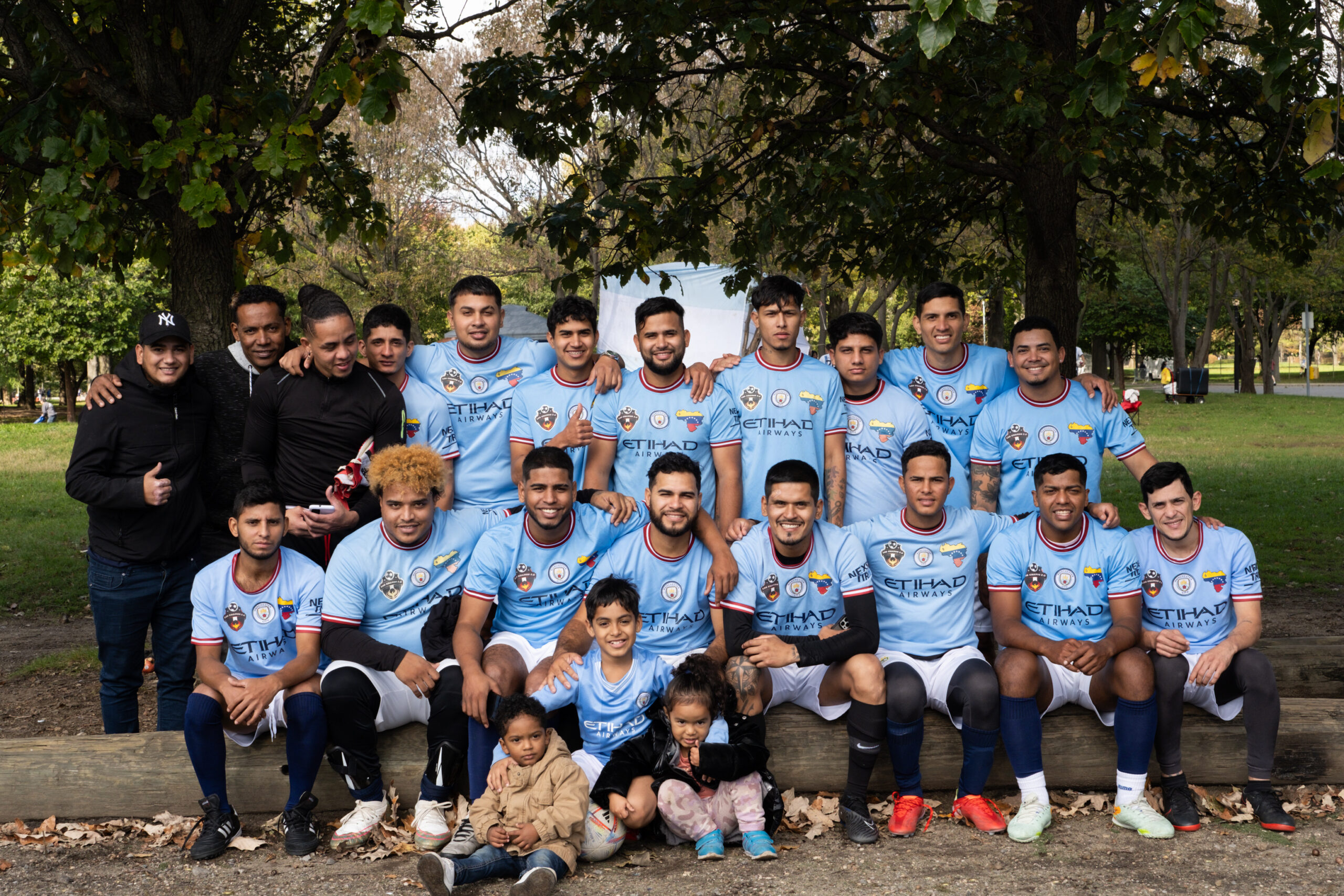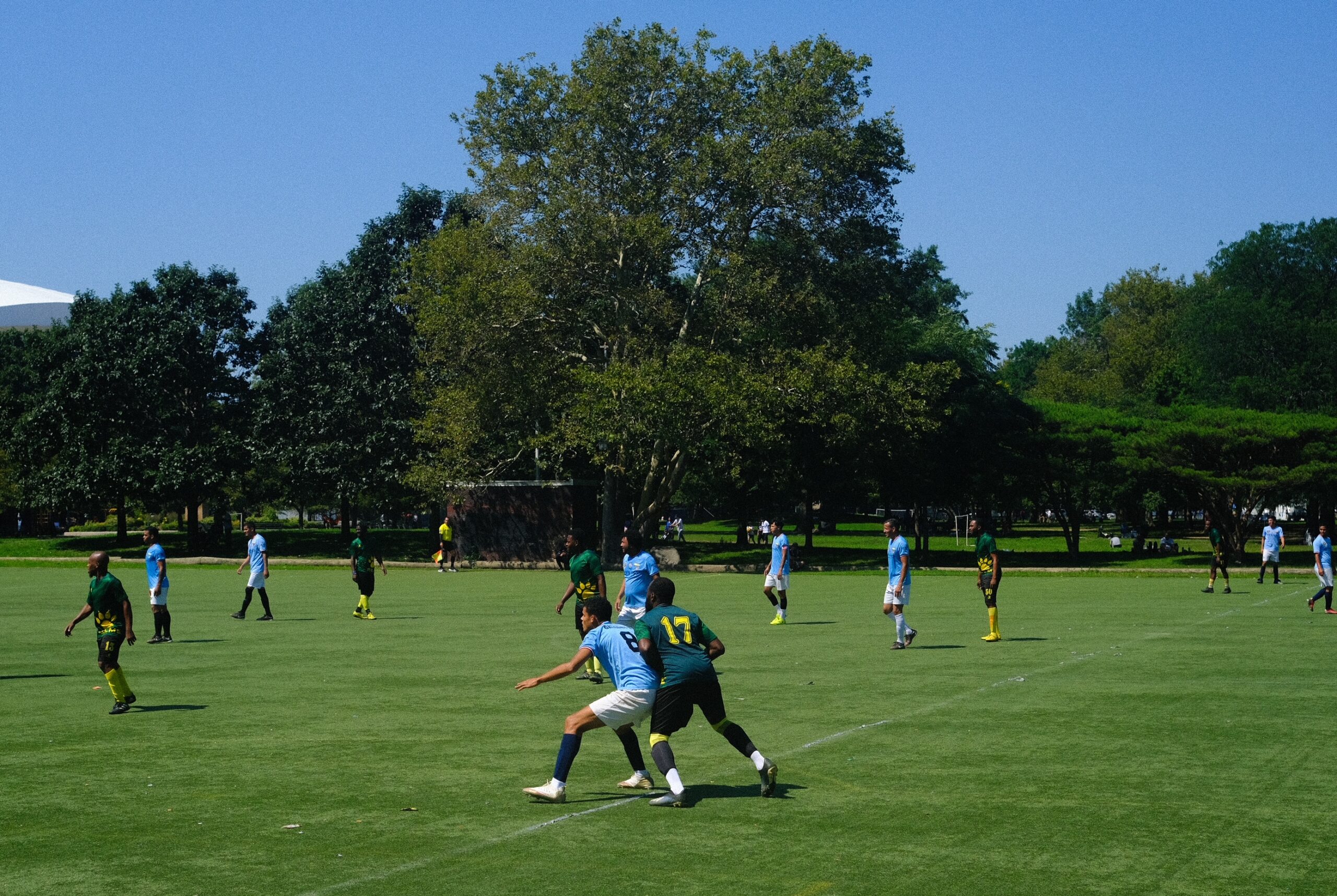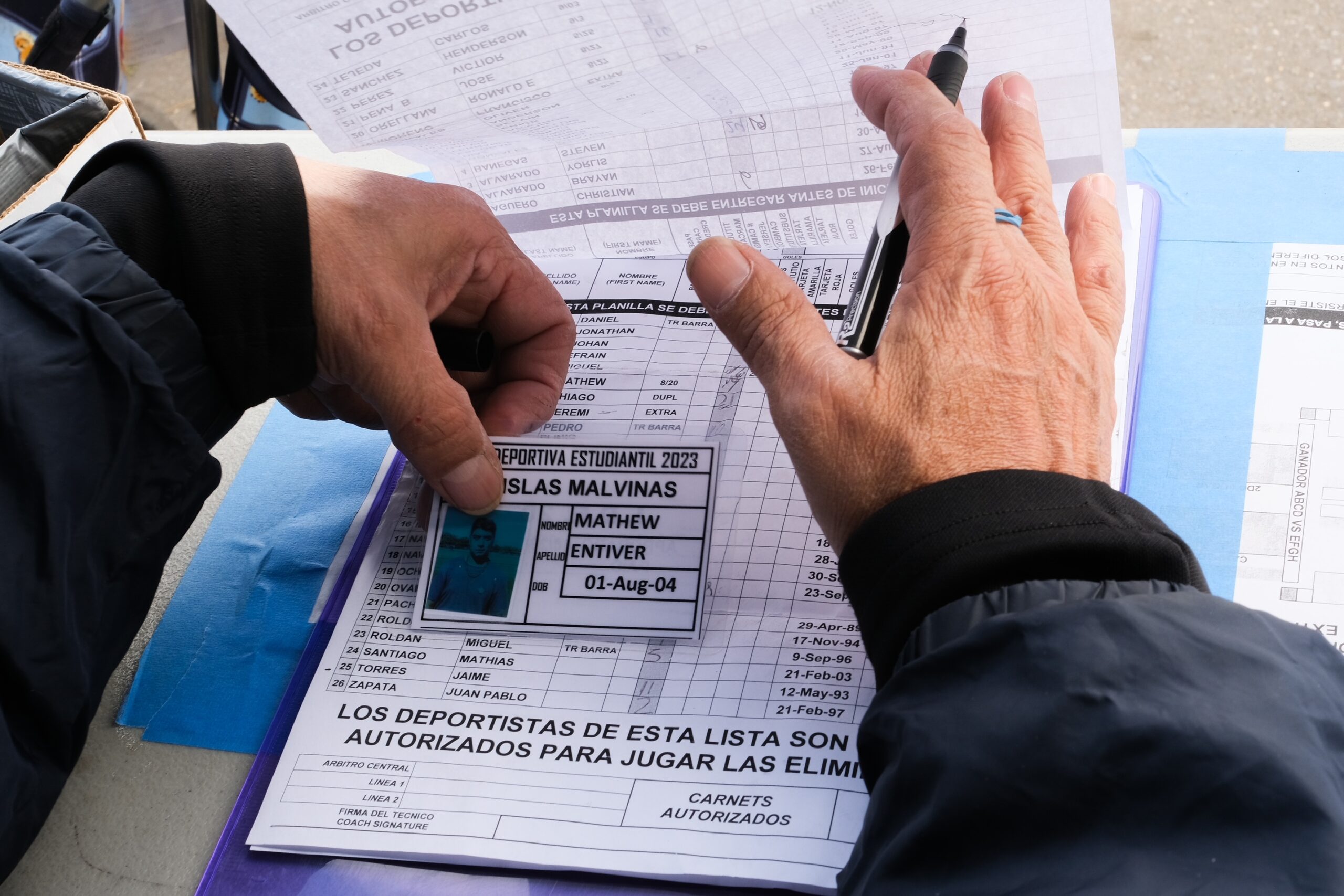
The Los Chamos F.C. poses for a photo on Oct. 15. (Credit: Sofia Mareque)
Rubén Bermúdez watched from the sidelines as the soccer team he coaches, Los Chamos F.C, engaged this fall in a heated contest against the Reggae Boys on a sunny field at Flushing Meadows Corona Park in Queens. Los Chamos players, in their vivid, light blue uniforms, slam into their opponents, a squad of Jamaican-heritage players in dark green and yellow jerseys.
Bermúdez’s team is mostly comprised of players who, like himself, are recent migrants from Venezuela. Calling to each other in Spanish across the pitch, they shout “cabeza” (head) and “aquí” (here), while the Reggae Boys yell in Patois. Knees scraped the ground, shoulders slammed, and tempers flared. The teams were evenly matched.
When Los Chamos broke through the defensive line and rushed to their opponent’s goal, the Reggae Boys did not run after them. The Los Chamos striker was obviously off-side, at least to the Reggae Boys. A referee confirmed the Los Chamos goal and the Reggae Boys erupted in protest.

The Los Chamos F.C. plays against the Reggae Boys on September 3. (Credit: Sofia Mareque)
Inevitably, as most soccer or “fútbol” fans know, the players mobbed the referee to argue their case, and eventually his hand shot out among the green and yellow crowd waving a red card. They stormed off in protest and the match ended.
The Los Chamos players gathered around their coach as he talked them down. The team has been playing together for half a year and it has only been a year and a half since Bermúdez arrived in the U.S.
Bermúdez and his wife, Alexandra, spent two months and seven days traveling to this country on foot. She was seven months pregnant when they started their journey. Ten months after arriving in New York City, Rubén Bermúdez founded Los Chamos F.C. His team captain and compatriot, Alfonso León, arrived in October 2022 with his wife and two children. Another team member, Gustavo Saavedra from Peru, arrived in February 2023. Los Chamos is one of hundreds of soccer teams that play each weekend at the public recreation grounds better known simply as Corona Park.
On this warm Sunday in September, fans set up barbecue grills, lawn chairs and party tents to watch their friends and family play fútbol. A four-foot-tall speaker played “Brujeria,” the bouncy hit song by the salsa band El Gran Combo de Puerto Rico. Children swarmed to a vendor calling out “Espumillita, Espumilla aquí,” announcing her cooler filled with mounds of pink and white meringue, an Ecuadorian sweet, that resembles “espuma,” Spanish for foam.
The nine soccer fields in the almost 900-acre park are fully booked on Sundays. Like other parts of Queens, the venue reflects a microcosm of Latin America – with the region’s most popular sport as a magnet. Fútbol is an immutable element of Latine culture.
Love of soccer bridges regional, ethnic, linguistic and class differences wherever Latin American communities appear. The park has been a haven for immigrant Latine fans of the sport for decades. Los Chamos is one of a long line of fútbol teams to find a home the pitches of Corona Park.
“The truth is, this is just another world,” said Margarida Guilarte, who inherited her soccer league 17 years ago – at age 23 — after her father’s death. “You don’t even realize that you’re in New York.” For the Guilarte league, she manages dozens of teams that have played in the park for 41 years.
Her childhood friend, Martín Chávez, also inherited from his father, Jorge Chávez, a 20-team league, La Gran Liga de Fútbol, that has been active for 37 years. And Salomon Wiesner took over from his father a group of 20 teams with a two-decade history and players primarily from Ecuador, the Fedeiguayas Soccer League. His brother, Nacho, referees their matches. In all, the park is home to seven leagues.
The Estudiantil Soccer League, presided over by Dino Dominguez, is the oldest league, and celebrated its 51st anniversary in May. Dominguez arrived in the U.S. from Ecuador on March 15, 1968, determined to succeed. “I wanted to take on the whole world,” he said. Every Sunday for the past 50 years, Dominguez watches his teams play on fields #1 and #3.
For the owners, managing a league is a full-time job, even if it cannot be their only source of income. Each player must be issued an identification card by their league, owners need to acquire and pay for permits to rent the playing fields, game schedules need to be managed, registration fees handled and referees booked.
For league owner Martin Chavez, the hardest parts of the job include managing the players’ tempers. Fights and scuffles routinely break out on the pitch. Even with referees, this is still “fútbol del barrio” or “neighborhood football,” and there are very few rules in the streets of Quito, Ecuador, or Oaxaca, Mexico.
“Sometimes I feel like I’m running a daycare,” he said.
Each league is made up of 300 to 400 dedicated players who take their competitive Sunday matches seriously. More than 2,000 players compete in the park each weekend.
“If you live and breathe soccer, you come here and that’s what you do, that’s what your culture is,” said Guilarte, who inherited her league. She recalls looking over her father’s accounts after his death and discovering that running the league sometimes cost him more money than he received in fees. “But that was his passion, and he loved it,” she said.
League owners, who all decline to discuss their finances, say managing their organizations requires a significant amount of time and expense, especially for recently arrived immigrants, as was the case for Jaime Guilarte and Dino Dominguez when they started their own leagues.
Many of the expenses are borne by the teams. For Los Chamos to participate in Dominguez’s league, Bermúdez must pay $2,200 per season, which runs from May to October. (“I won’t lie to you, Dino made it a bit cheaper for me,” he said.) Some Los Chamos players have had to leave the team because they couldn’t pay their share of the league fee, but when he can, Bermúdez will help cover the costs to avoid losing players. Additional team expenses include uniforms and $150 per match for referees.

Jorge Sotello administers Islas Malvinas players in the Estudiantil Soccer League on Oct. 15. (Credit: Sofia Mareque)
New teams of new players are constantly reshaping the competition in the park and reflecting the political and economic upheavals in Central and South America. Teams from Ecuador, Venezuela, Paraguay and Guatemala are on the rise.
For newer players like Los Chamos, playing in the park provides both an escape and sense of belonging, as it has for immigrants who came before them. Migrants like Rubén Bermúdez and his captain León endured enormous hardships to get to the U.S., which continue when they arrive. Many struggle to find employment and housing once they’re here.
Bermúdez and his wife began their journey from Colombia where they crossed the jungle in the Darién Gap on foot to reach Panama. He had expected the mountainous rainforest to be the most difficult part of their trek, but each leg of their trip presented challenges.
“Once we started traveling, we realized every country had its own complexities and every country got a bit harder,” Bermúdez said. “It was like a video game in which every level got harder.”
As they crossed the Río Bravo, Alexandra Bermúdez’s contractions began. Their daughter, Temari Saíd Bermúdez Guanchez, was born by emergency cesarean section on June 20, 2022, in Texas, a day after they crossed the border.
When asked who his favorite player is, Bermúdez first responded “my brother” and then “my captain Alfonso, number 10, a complete player who pushes and motivates the others.” Although the question was intended for major international players (to which his answer is Lionel Messi), the coach was referring to Alfonso León of Los Chamos. As a child in Venezuela, León dreamt of becoming a professional soccer player, but his parents couldn’t afford to help him achieve that goal.
León and his family spent 51 days traveling through eight countries on foot and by bus to reach Texas. On May 6, 2023, while working in a restaurant in the Flushing neighborhood of Queens, León fell and fractured both his hands. Since then, the family of four have been living in a shelter, while he awaits surgery and his wife looks for a job. But soccer is still a priority.
“It means everything,” he said. “I’ve had problems with my mother, my wife, but I’ve never stopped playing. I don’t think I will. Even with my fractured hands, I’ll keep playing until the day of my operation,” León said. “I have a lot on my mind, I don’t have a job, sometimes it’s hard for me to buy food, but I’ve never missed a match.”
For León’s teammate, Gustavo Saavedra, a native of Peru, playing soccer helps him feel less alone in his new home and takes his mind off losing his mother who died in October. “The only time I forget about everything is here,” he said.
Saavedra’s life has always been dedicated to soccer, both as a player and as a multimedia sports journalist when he lived in Peru.
Giving up soccer was never an option for many of the newer players in the park. David Trouille, author of “Fútbol in the Park: Immigrants, Soccer, and the Creation of Social Ties,” emphasizes that the soccer field provides a sense of community, safety and independence. “This is a place where they’re generally in charge,” Trouille said. “They created the space versus elsewhere where they’re not always in charge and are more beholden to other authorities. I think that autonomy is really important.”
Each team has its own story. Barrio 13, formed this year by their 28-year-old captain Claudio Tomás, was created to accommodate a growing number of family members and friends of Ecuadorian players in Salomon Wiesner’s league that have arrived in the last couple of years. Tomás grew up with most of his teammates, in their neighborhood – or “barrio” in Spanish – in Compañía Alta of the Cotopaxi province in the Sierra region.
Tomás, who came to New York three years ago, points to the eagles on their blue and yellow uniforms, which are made in Ecuador. “We always have to be like eagles,” he said. “They free their minds, they fly alone, and we need to stay above the ground.”
Monday through Friday, he and his teammates work, mostly in construction. They reunite on Sundays. “We feel good because we gather among Latinos,” Tomás said. “The truth, is I feel bad sometimes, because everywhere else they speak English and we don’t really understand. But with fútbol we forget about everything else, and in that moment, we feel joy.”
Tomás left Ecuador in 2020. “Everyone should know that due to the crises, I couldn’t find a job, we barely had anything left,” he said. “I miss it because my parents and my siblings are there, and maybe one day I can return. But my daughter and my family are here illegally, and if we leave and want to return, we can’t come back. Until then we have to keep fighting.”
Linda Machuca, the former consul general of Ecuador in New York, breaks down Ecuadorian migration to the U.S. into two phases. The first large wave occurred at the end of the 1990s, mainly because of an economic crisis. The second wave, which is still unfolding, began during the Covid-19 outbreak.
“Historically, it was an economic reason to migrate,” she said. “Now it’s different, it’s more because of violence plus economics.” Ecuador’s borders became more permeable during the pandemic, making it easier for criminal organizations to penetrate the country. Aggravated by a change in government in 2020, people went to hospitals looking for medicine and left empty-handed, public schools started closing and violence increased.
As of 2019, Ecuadorians were the largest Latine nationality in Queens, making up 21% of the Latine immigrants in the borough. The largest Latine groups currently seeking asylum in New York City are from Venezuela, Ecuador and Colombia — making up 41%, 18%, and 13% of asylum seekers, respectively, according to data provided by the city and state in August 2023.
The data includes Tomás and Rubén Bermúdez. They say they are dedicated to building teams for their communities, despite the costs entailed.
León and Bermúdez both left Venezuela because of the dire economic situation and to seek a better life for their children. “In Venezuela, the situation was very difficult,” Bermúdez said. “No food was available. Even if you worked every day of the week, of the month, you still couldn’t buy any because it was excessively expensive. And then crime began to spiral out of control. It’s not an excuse but the hunger people felt motivated their crimes.”
Venezuelan migrants, who currently number 7.2 million people abroad, are also influenced by political persecution, according to Katherine Martínez, a coordinator of labor migration and mobilization at the International Labor Organization.
Martínez refers to “el luto migratorio” or “migratory mourning,” which is a feeling of nostalgia that occurs when migrants have to abandon their countries. “Being in contact with a sport like soccer affects your state of mind,” she said. “You’re tied to something that is yours, and in a way, that counters this migratory mourning that you’re experiencing as a person that had to forcibly leave your country.” When the players step onto the fields, they leave their mourning behind for 60 minutes.
Weeks after their heated match with the Reggae Boys, Los Chamos was eliminated from Dominguez’s tournament. It was a Sunday in mid-October and the trees had lost some of their leaves. It was a lot colder and Bermúdez wrore not one, but two Yankees caps. The team was now competing in “La Recopa,” a tournament for eliminated teams to select a winner amongst those who already lost. “Besame Mucho” (Los Panchos’s version) played from a loudspeaker.
Less evenly matched this time, Los Chamos had a clear advantage over CD Predator, and they were up 2-0 at half time. As usual, tensions ran high and scuffles broke out, but it wouldn’t really be fútbol without them. León got a red card and CD Predator was awarded a penalty. They scored. The game ended with 2-1 win for Los Chamos. As the final whistle blew, a frustrated CD Predator player kicked the ball into an opponent’s head and a fight broke out.
After the commotion died down, most of Bermúdez’s players broke off to watch other matches. On Salomon Wiesner’s pitch, Barrio 13 faced another team from southern Ecuador. On Dominguez’s pitch, the Argentinian team, Las Islas Malvinas, played against the Salvadoran team, C.D. El Roble.
But Gustavo Saavedra hung back. Ready to go home, he started changing out of his uniform. He removed his long black socks, revealing two personalized shin guards. The right guard is a collage of images of his son Sergio, who’s almost two. The left is covered in images of Paula, his mother.



